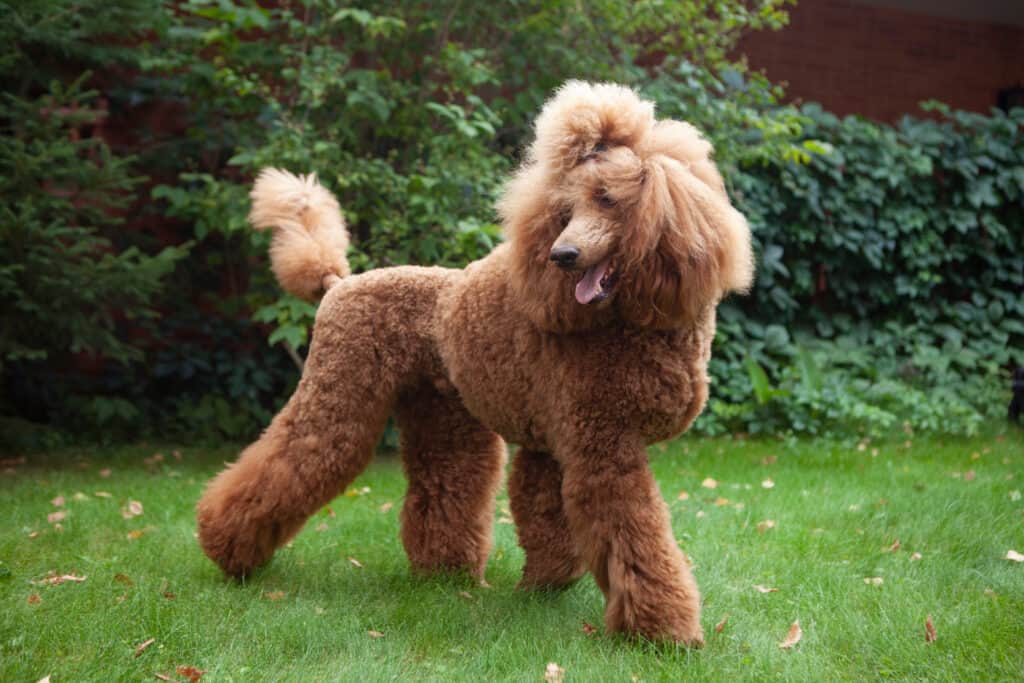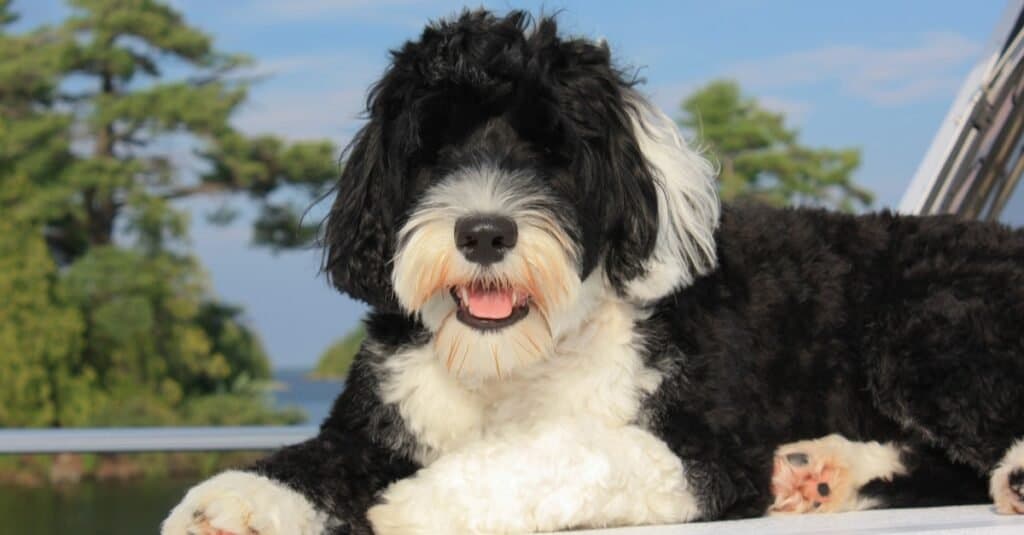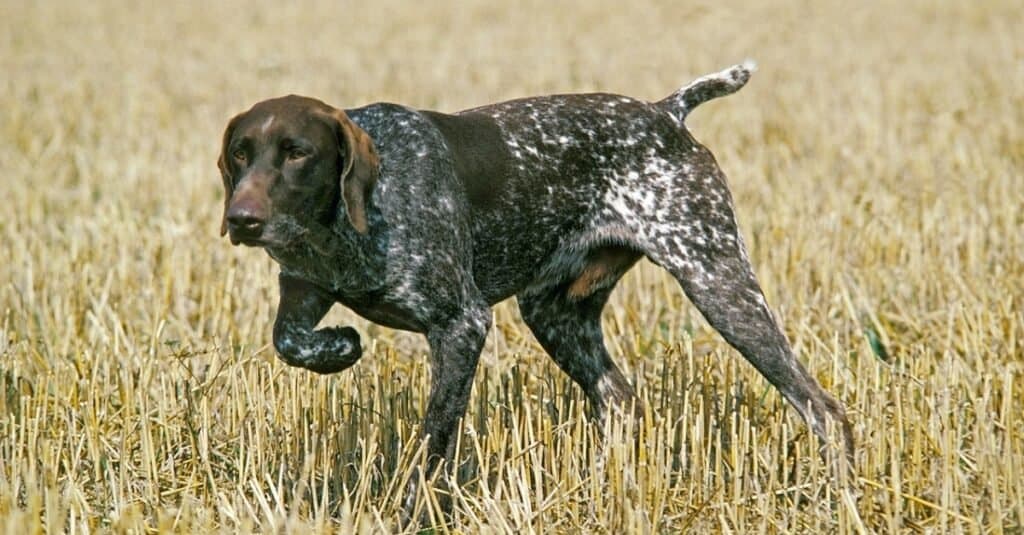Some dogs were simply made for the water. A desire to swim is ingrained in their DNA, and their bodies are designed to move through water. Some water dogs even possess the unique trait of webbed feet, a trait of many other water-loving creatures as well.
So, what are webbed feet, and why do dogs have them? Let’s learn the answer to these questions and introduce nine impressive dog breeds with this water-centric trait!
What Are Webbed Feet In Dogs?
The term ‘webbed feet’ refers to thick connective tissue that connects each of the toes. This webbing may cover the entire base of the foot or just the toes. The amount of webbing is often based on how much time the animals spends in the water. Some of the most well-known animals with webbed feet include ducks, frogs, otters, beavers, and flamingos.
Why Do Some Dogs Have Webbed Feet?
All dogs have a small amount of webbing between their toes, but some breeds have truly webbed feet. While many believe webbed feet only improve a dog’s swimming abilities, there are actually multiple benefits to having webbed paws!
The benefits of webbed feet in dogs include:
- Improved swimming abilities
- Help with digging and hunting underground prey
- Better traction in swampy areas
- Improved balance in the mud
Due to the assistance that webbed feet offer, many dogs with these unique feet were originally bred for hunting purposes.
Let’s discuss nine of our favorite dog breeds with webbed feet, along with the details of how these breeds originated!
Labrador Retriever

The Labrador retriever was originally bred to be a fishing dog, as well as a retriever gun dog.
©Jagodka/Shutterstock.com
Labrador retrievers are one of the most well-known dog breeds. Not only are they friendly and goofy, but they are also one of the most loyal pups. This is why the Labrador retriever are one of the most treasured family dogs, and why they are commonly trained for service. For example, Labrador retrievers often hold positions in search and rescue, guiding, and drug detection.
The Labrador retriever was originally bred to be a fishing dog, as well as a retriever gun dog. This means that some of the first Labs were charging through the water to catch fish and hunted birds. Their webbed feet helped them perform these tasks with ease! Though most Labrador retrievers are not used for hunting these days, their love of the water remains ingrained! In fact, most Lab owners have a hard time keeping their pup away from the water.
Chesapeake Bay Retriever

The Chesapeake Bay retriever has long been known for its duck hunting skills.
©Kerrie T/Shutterstock.com
The Chesapeake Bay retriever bears a striking resemblance to the Labrador retriever, but their curly coat ultimately sets them apart. Aside from having a similar appearance and work ethic, they also have a desire to be near the water. However, if the Labrador retriever is a water lover, then the Chesapeake Bay retriever is a die-hard water fanatic!
The Chesapeake Bay retriever has long been known for its duck hunting skills. Their reputation for being great water dogs began in the 1800s. Though many factors play a role in this this breed’s agility, their webbed feet help them get the job done! Whether leaping into a lake to retrieve a duck or swimming for fun, this dog is happy in the water!
Newfoundland

The Newfoundland has a water wicking coat!
©Pandas/Shutterstock.com
In addition to webbed feet, the Newfoundland also has a water wicking coat! These qualities aren’t surprising, as they were originally bred to accompany fishermen in Canada. The Newfoundland helped fetch fish in the water, and even helped fishermen pull their nets back into the boat.
This impressive water dog may have been bred for work, but they are known for being wonderful companions as well! These dogs love to be a part of a family, and they are even great around small children. The Newfoundland is the definition of a well-rounded pup!
American Water Spaniel

Every inch of the American water spaniel was designed to thrive in the water.
©Steve Bruckmann/Shutterstock.com
You know a dog is made for the water when it is a part of their name! Similar to the Newfoundland, every inch of the American water spaniel thrives in the water. They have thick webbed feet that help them glide effortlessly through the water. And their water wicking coats help them dry off quickly! They also have slim and athletics frames, so nothing slows them down while swimming.
Like many of the dogs on this list, the American water spaniel was originally bred for work. They are believed to have been bred for bird hunting and assisting fishermen. However, they can be wonderful family dogs as well. Be sure to factor in 30 minutes of exercise each day, as this pup requires plenty of daily stimulation. And of course, providing water-based exercise will be most appreciated!
Poodle

Owners of poodles are often surprised to learn they were originally bred to retrieve waterfowl.
©Diana Kellior/Shutterstock.com
Poodle parents are often surprised to learn this breed was originally bred to retrieve waterfowl. The poodle is agile and skilled in the water, and this is partly due to their webbed feet. Their sleek frame also helps them move quickly in the water. They make the perfect hunting companion for swampy hunting grounds. Though they don’t have an oily or water-resistant coat, their soft curls are known to dry quickly!
Poodles come in many shapes and sizes, but they all have the unique webbed toes and love for water. Even the toy poodle peaking over the edge of your neighbor’s handbag would be thrilled to get wet and wild!
Portuguese Water Dog

Portuguese water dogs were known for their ability to herd schools of fish into nets.
©Lynda McFaul/Shutterstock.com
The Portuguese water dog was originally bred for herding, but not the standard herding of livestock that we often see. These dogs were known for their ability to herd schools of fish into their fisherman’s nets! This skill allowed fishermen to scoop up fish in record time. Their webbed feet helped them swim skillfully through the water, as well as find traction on the slippery floor.
Though most fisherman no longer use this method of gathering fish, the Portuguese water dog is still a popular breed. They are both intelligent and dedicated, making them an incredibly loyal companion! This breed could be the perfect addition to any family.
German Shorthaired Pointer

These multitasking dogs can hunt, point, and retrieve.
©iStock.com/slowmotiongli
The GSP is one of the most well-rounded gun dogs, ready to retrieve a hunt across any terrain, including water. Their webbed feet help them navigate muddy land, run through open marsh, and even swim through bodies of water. No matter where the bird lands, the German shorthaired pointer can collect it.
They may be made for hunting and retrieving, but they make wonderful companions as well. As long as they live in an active home with plenty of daily exercise, they will love any willing family!
Dachshund

Dachshunds were originally bred to hunt small animals and vermin.
©iStock.com/NORRIE3699
Dachshunds may be small, but they sure are mighty! These dogs were originally bred to hunt small animals and vermin. This meant they had to be skilled at digging. Many of these critters live within underground tunnels and dens, so the Dachshund would dive into the ground and seek them out! Though webbed feet are most helpful for swimming, they also assist in digging through the soil.
Dachshunds are not used for hunting anymore, but they are one of the most popular dog breeds in the world. Not only are these canine friends adorable, but they are loyal and loving to their family. There are many proud Dachshund parents out there!
Otterhound

The otterhound is a well-known dog breed around the United Kingdom.
©Lourdes Photography/Shutterstock.com
The otterhound is a well-known dog breed around the United Kingdom. They were originally bred to hunt otters in England, hence their name. They certainly needed webbed feet to chase their hunt through the water. Hunting otters is now illegal in the country of England, but these pups are used to hunt other species. The otterhound is also considered a skilled scent dog, so their skills come in handy for tracking many animals.
In addition to being skilled hunters, otterhounds happen to be absolutely adorable as well. Many dog lovers in the UK are proud otterhound owners. They make wonderful additions to any family and are loyal, friendly, and downright goofy pups.
Final Thoughts
While all dogs have a thin webbing between their toes, the breeds we discussed above have impressive fully webbed feet! Their webbing has helped them complete important tasks for hundreds of years, and still serves as a skillful trait. Dogs with webbed feet are some of the best hunters and swimmers around!
The photo featured at the top of this post is © Tom Meaker/Shutterstock.com
Ready to discover the top 10 cutest dog breeds in the entire world?
How about the fastest dogs, the largest dogs and those that are -- quite frankly -- just the kindest dogs on the planet? Each day, AZ Animals sends out lists just like this to our thousands of email subscribers. And the best part? It's FREE. Join today by entering your email below.
Thank you for reading! Have some feedback for us? Contact the AZ Animals editorial team.






